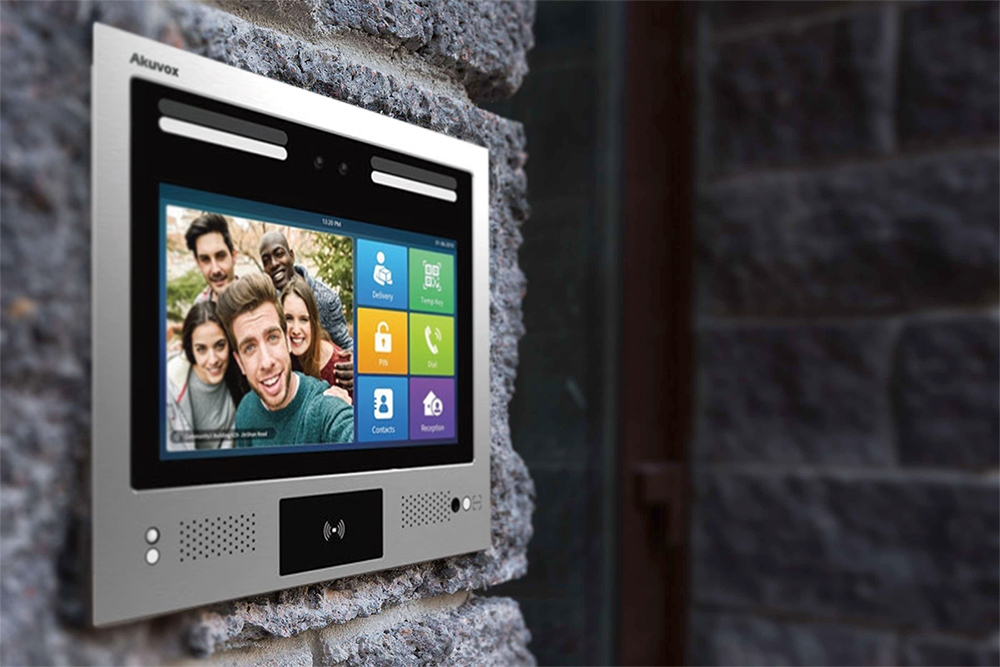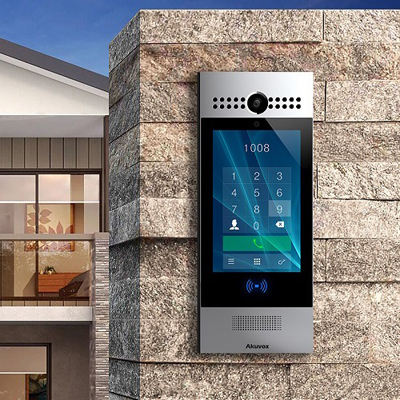How to Choose the Best Residential Access Control System
You are aware of the need of maintaining the safety and security of your residential property, which includes managing entry into and inside your apartment complex. But it might be difficult to find a home access control system that meets all of your needs. Before committing to an access control system, this article will guide you through all you need to know.
video intercoms
What is an access control system for homes?
How to control residential property access
What are the most prevalent home access control types?
How to choose a home access control system
The top home security access control system
What is an access control system for homes?
A home access control system is a method for automating entry to a residential property and ensuring that only authorized individuals are permitted to enter. Access control systems are implemented at all building entrances, gates, inner doors, and elevators. There are several kinds of home access control systems, but they all have the same purpose: to make buildings safer and more accessible.
Traditional metal keys and locks may suffice for building access control systems. However, investing in the appropriate solution is a straightforward, cost-effective, and efficient method to enhance your home, so you should explore your alternatives. An outdated lock-and-key system may keep off uninvited guests, but it is inconvenient for your present residents and employees to handle.
Observe how New jersey Gate soperates:
How to control residential property access
All entrances, from gates to doors, may benefit from access control to guarantee that only authorized individuals are permitted to enter. Gate and door access control systems enable you to keep entries secured and secure 24 hours a day, 7 days a week, so that only authorized residents, employees, and visitors may gain entry.
The majority of access control systems consist of the following elements:
The control panel maintains information about tenants and their access rights. Many older access controllers save this data locally on a physical device, while many modern systems store it on the cloud, making it available remotely.
There are a variety of credentials available. Your building may still use metal keys, or you may have switched to key fobs or cards. As credentials, intelligent access control systems may also accept mobile devices or fingerprints. In the end, all credentials serve the same goal of preserving information about the user’s identity and access permissions.
Every entrance requires a reader to control access and scan credentials. If the key fits a conventional metal lock and key, the door will open. With advanced systems, however, readers scan credentials and transmit encrypted data to the control panel. The control panel unlocks the door if the authorized person is present.
The door release mechanism is a device that opens the entrance so that tenants, guests, and workers may enter once their credentials have been scanned. It receives signals from the control panel and opens the door when an authorized user approaches.
What are the most prevalent home access control types?
There are several methods to handle entry to your residential complex, ranging from traditional metal keys to contactless cloud-based solutions. The ideal apartment access control system for your property will rely on its specific requirements. Nevertheless, the majority of multifamily structures benefit from a mix of access techniques.
The four most common kinds of home access control systems now in use are:
RFID systems and cloud-based access control
Smart locks
Keypads
1. RFID systems
RFID key technology has existed for a long time and remains the most common option for hotels today. Each tenant and employee is issued a key card or fob that must be scanned at the door to obtain entry. You may use these systems to regulate access to more than just the front entrance, including gyms, laundry rooms, parking garages, and package rooms.
Typically, RFID access control systems are inexpensive to install, but as you replace lost keys and create new ones for relocating tenants, the price rapidly escalates. In addition, these systems do not let visitors to seek entry, resulting in packages being left outside and potential residents being unable to take tours.
Provide self-guided tours by means of ButterflyMX:
2. cloud-based access management
In the cloud, a cloud-based access control system functions and saves data. With a cloud-based access control system, authorized users may unlock doors for themselves or visitors using any internet-connected device. Your tenants and workers will essentially be able to control access from anywhere. Additionally, they may update the resident directory, adjust access restrictions, and monitor entry logs remotely without being on-site.
Unlike RFID systems, cloud-based access control solutions often include visitor management functions. The ideal technology for residential buildings, for instance, is a cloud-based video Gate and intercom. Gate and intercoms placed at the building’s front entry enable visitors to communicate with any resident or employee. Numerous cloud-based access control solutions are mobile-based.
Smartphone-based access control entails what?
With mobile cloud-based access control, your workers and residents utilize their mobile devices as their access credentials, such as smartphones, tablets, and smart gadgets. This may be used in several ways. Some access readers interact with tenants’ mobile devices through Bluetooth or WiFi to authenticate access. Other systems run through mobile applications, allowing users to receive calls from visitors, accept packages, and unlock the door using their cellphones.
3. Smart locks
Physical keys will soon become obsolete. Smart locks allow residents to open their doors using a PIN code or smartphone in lieu of traditional metal keys.
Smart locks are handy since tenants no longer need to carry keys, and your staff will no longer have to deal with the inconvenience of manufacturing them. However, smart locks are not the most effective technique to regulate front door access since once homeowners provide a visitor with the PIN code, the guest may reenter the entrance at any moment. Utilizing smart locks as door access control for specific apartments inside the building is the optimal approach.
4. Keypads
As with smart locks, keypads are a more convenient alternative to metal keys and locks. Keypads, which allow users to input a PIN number to gain entrance to a building or room, are an excellent method to control access to your property. Some keypad entry systems let renters to unlock the door using a mobile application.
The keypads are handy for residents and workers, but there is no way for guests to request admission. Therefore, they are more suited for usage within the building than at the main door, where visitors and delivery couriers also arrive.
How to choose a home access control system
Now that you are aware of the many forms of access control, how do you decide which one to purchase? You want to invest in a contemporary system that is scalable, dependable, and simple to administer. Using a cloud-based, unified access control system is the optimal method for achieving this goal. Choose a cloud-based system with practical hardware, such as smart locks and keypads, to provide a smartphone-based, hands-free experience across the whole facility.
Important characteristics of a cloud-based access control system:
Camera: Ensure the safety of your building by selecting a system with a camera integrated into the access control hardware. Thus, you and your renters may use live video to visually confirm who is entering the property. The most effective method is to install a video Gate and intercom at the front entrance.
The last thing you want is to invest in technology that neither your residents nor your employees will use. Therefore, it is vital to invest in a system with an excellent mobile application if you want to provide smartphone access. Check Google and the Apple Store for user feedback to confirm the app is well-received.
Integrations: Your access control system can simply interface with other devices and applications thanks to the cloud. Select an access control system that can interface with your other smart devices, such as locks and keypads, to provide the smoothest experience across the facility. Additionally, you may save time by selecting a system that interfaces with your property management software so that the resident directory is immediately updated.
Which credentials for access control should you use?
Key fobs and access cards function similarly to conventional keys in that anybody in possession of the credential may get entry. Unfortunately, this is not the most secure method for managing access, since keys may be stolen, lost, and used by unauthorized individuals. However, your residents are significantly less likely to lose their cellphones, making mobile credentials-based solutions more secure.
In addition, the popularity of touchless access has increased significantly since COVID-19. It is a wonderful investment for your home since it makes entry more easy and accessible for everyone, as they no longer need to keep track of keys.
The top home security access control system
It is difficult to find an all-inclusive home access control system nowadays. Fortunately, New jersey Gates provides the top-rated home access control system on the market today, allowing you to manage everything from a single smartphone. Every day, more than 500,000 users utilize ButterflyMX, and the system now has over 7,000 five-star reviews. It is the optimal answer for all sizes of multifamily residences.
When you pick New jersey Gates as your access control system, you get a robust collection of devices that are seamlessly linked. Together, these devices offer a safe and easy solution for your home property.
The New jersey Gates unified property access solution comprises the following:
Intelligent video Gate and intercom to regulate entry at the front door of the property
Keypads for inside secondary entrances, amenity areas, and other doors
Elevator controls to guarantee that only the proper floor is accessible to guests.
Key lockers provide restricted access to apartment units using conventional locks and keys.
Integrations with smart locks to provide smartphone-based unit access from a single centralized system.





